EPoX EP-5P945 PRO: Budget 945P Performance
by Gary Key on September 11, 2006 4:45 AM EST- Posted in
- Motherboards
Features and Layout
EPoX designed a well laid out board with all major connections easily reached. The layout provides very good clearance for all cards and most components and was very easy to install in our mid-size ATX case. The board features a well-designed 4-phase voltage regulator power design that provided superb stability during general usage and light overclocking. EPoX installed a combination of solid state capacitors along with high quality Sanyo electrolyte capacitors.
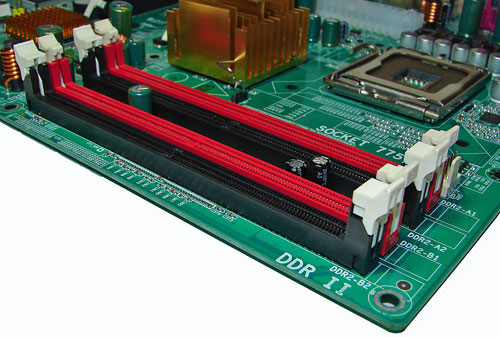
The DIMM module slots' color coordination is correct for dual channel setup. The memory modules are easy to install with a full size video card placed in the primary PCI Express X16 slot.
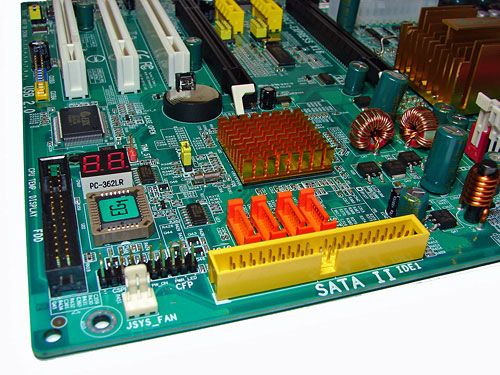
The orange ICH7 SATA ports are conveniently near the board's edge and in front of the to the yellow IDE port connector. Unlike other recently reviewed boards the SATA ports are not color coded for primary and secondary operation if this is important to you. We found the positioning of the SATA ports to be excellent when utilizing the PCI slots or the single IDE port connector. The Intel ICH7 chipset is passively cooled with a low-rise heatsink.
The yellow IDE connector did not present any connection issues in our mid-size ATX test case. The location of this connector is very good for most cases and those users still utilizing IDE hard drives, though most will use it for an optical drive(s) instead. The chassis panel and system fan header are located on the left of the drive ports. The black floppy drive connector is located in an inconvenient position at the left edge of the board. The CP80P post port debug LED is to the right of the floppy drive connector and in front of the EPoX EG1 I/O controller chip. The two USB 2.0 headers are located on the left edge of the board next to the last PCI slot.
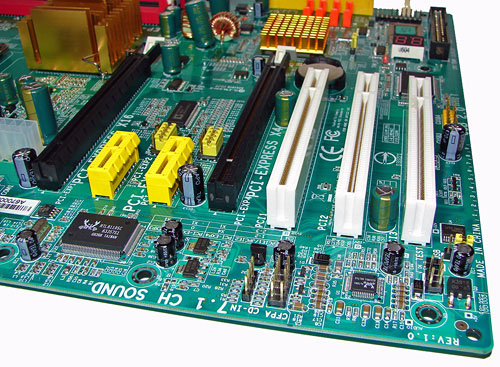
The board comes with two physical PCI Express X16 connectors, two PCI Express X1 connectors, and three PCI 2.3 compliant 32-bit connectors. The layout of this design offers an exceptional balance of expansion slots for a full size ATX board.
Returning to the CPU socket area, we find a limited amount of room for alternative cooling solutions. We utilized the stock Intel heatsink and heatsinks such as the Cooler Master X-Dream P775 that utilize the same footprint size as the retail unit without issue. However, we verified our Tuniq 120 Tower and Scythe Infinity would not fit properly in this area during our tests due to the close proximity of the 945P MCH heatsink. We doubt most users of this board would go to that extreme to cool the processor due to the limited overclocking capabilities of the board.
Our other fitment concern is the location of the 24-pin ATX power connector as the cabling tends to interfere with the CPU heatsink/fan during usage. EPoX places the four-pin ATX power connector next to the 24-pin ATC connector. The cabling to this connector proved difficult to install if the main power cable was already attached.
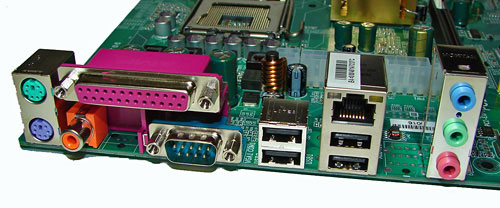
The PS/2 mouse and keyboard ports are located to the left of the LPT parallel port, 9-pin serial port, and S/PDIF Coaxial port. The first two USB 2.0 ports are located next and are followed by the LAN (RJ-45) port and the second pair of USB 2.0 connectors. The audio panel consists of 3 ports that can be configured for 2, 4, and 6-channel audio connections.
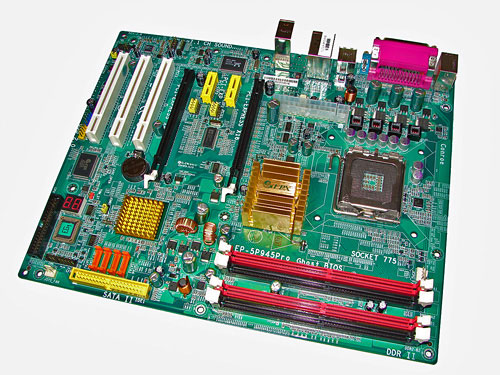 |
| Click to enlarge |
EPoX designed a well laid out board with all major connections easily reached. The layout provides very good clearance for all cards and most components and was very easy to install in our mid-size ATX case. The board features a well-designed 4-phase voltage regulator power design that provided superb stability during general usage and light overclocking. EPoX installed a combination of solid state capacitors along with high quality Sanyo electrolyte capacitors.

The DIMM module slots' color coordination is correct for dual channel setup. The memory modules are easy to install with a full size video card placed in the primary PCI Express X16 slot.

The orange ICH7 SATA ports are conveniently near the board's edge and in front of the to the yellow IDE port connector. Unlike other recently reviewed boards the SATA ports are not color coded for primary and secondary operation if this is important to you. We found the positioning of the SATA ports to be excellent when utilizing the PCI slots or the single IDE port connector. The Intel ICH7 chipset is passively cooled with a low-rise heatsink.
The yellow IDE connector did not present any connection issues in our mid-size ATX test case. The location of this connector is very good for most cases and those users still utilizing IDE hard drives, though most will use it for an optical drive(s) instead. The chassis panel and system fan header are located on the left of the drive ports. The black floppy drive connector is located in an inconvenient position at the left edge of the board. The CP80P post port debug LED is to the right of the floppy drive connector and in front of the EPoX EG1 I/O controller chip. The two USB 2.0 headers are located on the left edge of the board next to the last PCI slot.

The board comes with two physical PCI Express X16 connectors, two PCI Express X1 connectors, and three PCI 2.3 compliant 32-bit connectors. The layout of this design offers an exceptional balance of expansion slots for a full size ATX board.
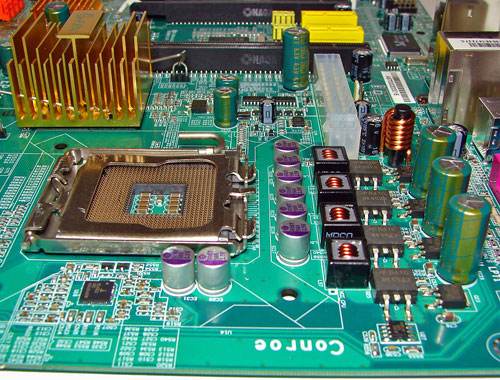 |
| Click to enlarge |
Returning to the CPU socket area, we find a limited amount of room for alternative cooling solutions. We utilized the stock Intel heatsink and heatsinks such as the Cooler Master X-Dream P775 that utilize the same footprint size as the retail unit without issue. However, we verified our Tuniq 120 Tower and Scythe Infinity would not fit properly in this area during our tests due to the close proximity of the 945P MCH heatsink. We doubt most users of this board would go to that extreme to cool the processor due to the limited overclocking capabilities of the board.
Our other fitment concern is the location of the 24-pin ATX power connector as the cabling tends to interfere with the CPU heatsink/fan during usage. EPoX places the four-pin ATX power connector next to the 24-pin ATC connector. The cabling to this connector proved difficult to install if the main power cable was already attached.

The PS/2 mouse and keyboard ports are located to the left of the LPT parallel port, 9-pin serial port, and S/PDIF Coaxial port. The first two USB 2.0 ports are located next and are followed by the LAN (RJ-45) port and the second pair of USB 2.0 connectors. The audio panel consists of 3 ports that can be configured for 2, 4, and 6-channel audio connections.










23 Comments
View All Comments
blckgrffn - Monday, September 11, 2006 - link
You don't know much about what you are talking about.How many PC's do you support? Do you really think people want to wait hours to days while you attempt to retrieve their data? Do you regularly back up 750 GB sata drives somewhere? 500GB drives? Even 400GB drives? I doubt it.
Do you really think raid 1 shortens drive life? Really?
I won't try to reason with you further.
The fact remains that several of my nearly 4 year old Intel based mobo's have native SATA raid capabilities. It's a staple of midrange computing equipment now, and I am very disapointed that intel decided to drive people towards more expensive solutions to get it.
Nat
yyrkoon - Monday, September 11, 2006 - link
The simple fact that RAID 1 is not a backup solution period. If you do use RAID 1 as a backup, you're in for a shocking experience when that file you accidently deleted, or that system that suddenly got corupted, and turning to your mirror *gasp* is exactly the same as the original (oh my !). Try explaining to the person why RAID 1 didnt save them then. RAID 1 does not really reduce a disks life no, but if that same drive where in a USB, or eSATA enclosure, it would live much longer, if properly cared for.We do enough service work here to know that REAL backup systems involve RAID 5,6, or 10, with a secondary backup of that data elsewhere (not even nessisarily a RAID array). Having worked in the industry since 92, I'd have to agree with you, I havent a clue what I'm talking about *rolls eyes*.
Now, since we're on a finger pointing expedition, I'd like to point out that generaly, when someone sees a budget product, they dont complain, in open public, about how it sucks because its missing this, or that. Generaly, *someone* just wouldnt buy it, and to be honest, RAID cards cost what now days ? 20 dollars ? Does this mean this RAID controller sucks because its so cheap ? I dont know, but what do you think you're getting when you pay $65usd for a motherboard with built in RAID ? think you're getting something good ? Now, if you're so cheap you wont spend $65-$90usd for a motherboard, why in the hell must you spend another $60+ for a HDD to operate RAID 1?
Your 4 year old system does NOT even come close to comparring with modern systems, if you still think it does, you're only fooling your self.
Now I suppose you have yet another quip suggesting I have no idea what I'm talking about.
blckgrffn - Tuesday, September 12, 2006 - link
You don't. You're the one who brought up RAID 1 as a backup solution and can't seem to grasp that it is really something else.You also haven't considered that when I say "clients" I mean home/education users that don't have massive tape drives or off site storage available to them for business class redundancy and backup.
If you really think that the ICH7R is "years ahead" of the ICH6R southbridge, good for you. For what it worth, I bought a shuttle 865 PE motherboard brand new for $38 (regularly closer to the $90-100 mark) and it has two seperate raid controllers, and not the junk chipsets like you find on the cheaper add in cards. If you think that the Silicon 3112 controller and the native intel controller are junk, especially when performing something so taxing as RAID 1, think about it some more.
MTBF. Do you know what that stands for? It sure doesn't seem like it. In a way that is easy to understand, RAID 1 can completely isolate you from HD failure. Get it?
And my beef with a $90 board, not a $60 one, is that it is missing a now standard feature. If it didn't have gigabit, I wouldn't buy it either. Personally, I like firewire too. What kind of RAID card would I get for $20?
For smaller disks, using a RAID 1 + backing up data (like movies in progress, etc) makes perfect sense, I'll agree. But drives don't live longer in external enclosures. Where would you get an idea like that? External enclosures get picked up, carried around, bumped, and unplugged much more frequently than one safely housed in a tower would. "Properly cared for"... right. Not to mention they usually aren't as well cooled as a HD in a case would be. Two of my freinds have had their external enclosures get corrupted after being hauled around for so long, I've been lucky but mine normally just sit attached to a tower for weeks/months on end.
Again, if you have a 750GB SATA drive, how do you reccomend insulating yourself against catastrophic failure? With HDTV becoming mainstream, and many start using these class of drives to store shows and their personal movie colections, this makes the most sense. This HTPC might be one of two or three total computers they have in their home.
I don't have to explain to anyone why I can't restore a file because of their raid array. "educating my customers" (and myself) makes sure that everyone involved understands the purpose of RAID.
And you know, when a system gets corrupted, it's an excellent opportunity to really flex your brain and remember why you use partitions.
If I can buy any $90 AMD board, or any ATI or Nvidia board for Intel and get raid, but not intel based one, doesn't that say something? Besides that, if I save the money on the motherboard, that makes the overall cost of the system, including the RAID array, the same, doesn't it?
I can point and laugh at a product, and express my disapointment, "in open public" all I want too. I am sure that I am not the only one who sees Intel's glaring shortage of quality and full featured Conroe capable boards as shame. Their are plenty of users who consider $90-$120 motherboard "enough".
Sigh, whatever man. Evidently you know it all here. You've worked in the PC business enough to know that hard drives never catastrophically fail. Maybe back when HD's were much more expensive or when removeable media was a viable quick and dirty alternative your arguments would hold weight, but when drives are so cheap and so large, it doesn't.
yyrkoon - Tuesday, September 12, 2006 - link
The same kind of RAID you would get on a $60 motherboard.
You've still managed to elude my point. My point being, that with USB/eSATA capable drive enclosures, RAID 1 isnt even nessisary, you isolate your data from the OS, use the drive only when needed, and it lasts a long long time. Meanwhile, if your data is TRUELY that important, you learn how to properly maintain your hardware, and pick up programs such as Spinrite, to help maintain / spot potential disk problems. I have 3TB storage currently in USB enclosures, and it stores all my data just fine, and is reasonably easy (whats easier than drag/drop file copying ?), and fast. Now, when your OS fails, reguardless if the HDD failed along with it, who cares . . . your data is stored somewhere else.
[Q}For smaller disks, using a RAID 1 + backing up data (like movies in progress, etc) makes perfect sense, I'll agree. But drives don't live longer in external enclosures. Where would you get an idea like that? External enclosures get picked up, carried around, bumped, and unplugged much more frequently than one safely housed in a tower would. "Properly cared for"... right. Not to mention they usually aren't as well cooled as a HD in a case would be. Two of my freinds have had their external enclosures get corrupted after being hauled around for so long, I've been lucky but mine normally just sit attached to a tower for weeks/months on end.
I get the idea of enclosed drives lasting longer from owning roughly 3TB of HDD configured as such. If you truely care about your data, you will take care of these drives, only turn them on only when needed, run a program like Spinrite on them once in a while to make sure the drive isnt going south any time soon, and buy enclosures with good fans (ball bearing). Just in case its not readily apparent (for you), isolating your data from the OS will also help increase disk life, just because the drive isnt constantly being accessed, because of swapspace, or other reasons. Also, trust me when I say that enclosed HDDs are MUCH more compact, reliable, and in-expensive (in the long run) than backing up to DvD. Finally its far more in-expencive than running RAID 1 3TB . . . Granted, you'll want to buy the HDDs, and enclosures seperately.
You mean 'MEAN TIME BEFORE FAILURE' ? Seagate lists this as 1.2 million hours on thier site, Western Digital doesnt (atleast for thier Caviar / comparable drives). Raptors aren't even in the same class (enterprise drives), but do have a warranty of 5 years, so I would also assume these drives have atleast a 1.2 million hour MTBF. They also cost alot more than a comparable sized Seagate Barracuda.
You mean setting aside legal implications ? What is so important about a TV show that you HAVE_TO store it on disk for long periods of time ? The simple fact of the matter is, you dont need to. I think that you'll find that most people would rather run RAID 0 in such a situation (or even RAID 5), and I'm one of them, albiet, if i want to watch a TV show, I'll turn the TV on, and watch it, not store it on HDD . . .
You're correct, you_can_do_whatever_you_want. . . As for $90-$120 being enough for a motherbaord, are these the same people who will pay $800 for RAID 1 750GB SATA ?! It just seems very silly to me, that someone would spend entirely too much for a 'reliable' storage system, but they wont pay jack when it comes to the parts that need the most care.
I dont, nor did I ever claim to know it all, however I DO know that RAID 1 is an antiquinted way of doing what most people can do now days for less money, and more storage. This isnt to say that there isnt a place for RAID 1, but in the home there are far better ways to ensure your data will be protected. In a data center, maybe not.
blckgrffn - Tuesday, September 12, 2006 - link
I think that we can fully agree to disagree here :-)This argument has been one of the special olympic variety :-p
Take it easy,
Nat
yyrkoon - Monday, September 11, 2006 - link
Well, I'm not telling you what you must buy, all I'm saying is that RAID often leads to premature drive failure, and can be avoided by spending a little more money on a drive that has a 5 year warranty (just about all Seagates with exception of white label drives). Do you think Seaate drives go bad as often when used / maintained properly comparred to other brands with a 1 year warranty ? I would beg to differ . . .LoneWolf15 - Monday, September 11, 2006 - link
This board would be a no brainer if it included RAID.It would also no longer be a "budget board".
In the same vein, I'm sorry it doesn't have FireWire, but I'm not surprised by it.
mostlyprudent - Monday, September 11, 2006 - link
Thanks for the review. I appreciate the wide range of motherboard/chipset/CPU/GPU reviews provided by AT.Going back to a discussion of price from the recent review of the Abit AW9D-Max board, it still seems difficult to justify a $180 spread between a budget and a high end Core 2 Duo compatible board. Are the $270 baords really 3x better than this board? I suppose there is even an argument that this board is a little over-priced for an entry level board. I am hoping that we get some good offerings from Nvidia and ATi to bring prices to a more reasonable level. I know nForce 5xx boards are on their way, but anything in the near future from ATI?
LoneWolf15 - Monday, September 11, 2006 - link
It's already been reported that ATI is backing out of the Intel chipset market, partly due to their acquisition by AMD.mostlyprudent - Monday, September 11, 2006 - link
I had read numerous reports in which the authors supsected that ATI's acquisition by AMD would lead to their departure from the Intel chipset market, but I had not seen any confirmation of those suspicions.